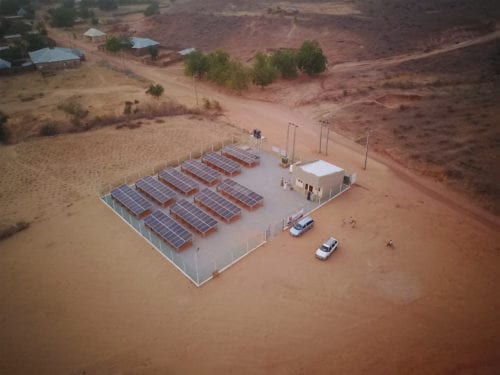Image courtesy of Nigerian Federal Ministry of Power

Nigeria’s Power Sector Is Struggling — Collaborative Business Models for Distributed Energy Resources Can Help
This article was originally published on https://theelectricityhub.com and reposted with permission.
Of the approximately 200 million people in Nigeria — sub-Saharan Africa’s largest economy — 85 million do not have access to electricity. Although the country has an installed generation capacity of about 12.5 GW (similar to that of Portugal, with its population of just 10 million people), it can deliver only around 4 GW due to inadequate transmission and distribution infrastructure, gas infrastructure limitations, and operational issues with generation. Moreover, the country’s poor grid infrastructure resulted in more than 200 grid collapse incidents in the past decade, causing widespread blackouts. As such, the country’s centralized grid alone cannot meet its power needs.
The poor reliability of Nigeria’s power supply carries significant social and economic consequences for the country. In sub-Saharan African countries, every 1% increase in the number of power outages is estimated to be associated with a 2.86% decrease in GDP. In Nigeria specifically, more than US$26 billion is lost annually due to poor supply reliability. Prolonged daily power outages are the norm for customers connected to distribution companies, from individual households to large industrial clients. As a result, Nigerians use an estimated 22 million small-unit fossil-fuel generators to generate electricity when the grid is not operational, which represents an economic and environmental burden for the climate and customers.
An emerging business model is poised to make a powerful contribution toward helping Nigeria meet its energy demands with the potential of adding 10 GW of new generating capacity and avoiding 30 million tons of CO2 by 2030. Utility-enabled distributed energy resources (DERs) offer a unique opportunity to advance decentralized renewable energy plants by promoting and implementing a solution that benefits all parties (win-win-win) as follows:
- Improving the financial performance of distribution network companies (DisCos, aka electric utilities) in Nigeria.
- Upgrading the power supply to the 15–20 million customers in Nigeria that rely on expensive, dirty fossil fuel generators.
- Increasing the opportunities for developers to build DER projects.
Utility-enabled DER projects combine the strengths of private sector developers and DisCos and are gaining momentum in Nigeria. These include distributed energy power plants (typically solar PV plants with storage) that are located near the site of consumption and that complement the existing electricity supply for a given area or client. As part of the initial capital investment, the DER developer may also invest in the modernization or reinforcement of the distribution network, thereby reducing electrical losses and covering the metering gap in the targeted area.
With conventional DERs, the project developer does not seek to optimize the electricity supply already available to the customer, choosing instead to compete with the DisCo to supply cheaper, more reliable electricity units to the end customer. By contrast, power plants associated with utility-enabled DERs are designed to supply electricity during typical power outage hours from the grid or distribution company and, therefore, capitalize on the existing infrastructure and power supply capabilities.
Why is this model attractive to utilities/distribution companies?
Utilities “enable” these DER providers to not only generate electricity but also directly sell it to the utility’s customers in the designated area. At first glance, this may appear counterintuitive, as it means the electricity sales of electric utilities will drop as these activities are taken over by the DER provider. However, the right adjustments to this arrangement can make it a win-win-win model, that ultimately results in significant revenue for the DisCo. This can be achieved via a distribution network usage fee, which allows DER developers to compensate DisCos for using the existing infrastructure. This, in turn, means the utilities benefit from increased revenue compared with the (pre-DER) baseline, as they currently struggle to collect payments from customers. Furthermore, the DER developer can work hand in hand with DisCos to address the needs of specific medium to large customers and targeted areas, instead of competing for customers.
Despite the initial interest demonstrated by DisCos and DER developers, and several pilot projects currently underway, a series of market barriers hinder the full potential of Nigeria’s innovative model of electricity distribution, including workforce development needs, aging infrastructure, a lack of structured project pipeline development, and limited financing options. RMI works with DisCos and DER developers to help address some of these barriers and ensure that positive action is taken on the ground.
Seizing the opportunity
The opportunity to scale DERs is well-timed, as the Government of Nigeria recently launched an energy transition plan and office — the first of its kind in Africa — to support exactly this kind of innovation. Launched on August 24, 2022, this plan aims to add 30 GW of new capacity to the national electricity supply by 2030, with at least 30% coming from renewable energy sources, and achieve net-zero emissions by 2060. DERs are one of the pillars of this just and equitable transition plan, which will require an annual budget of US$10 billion through 2060.
With support from GEAPP, USTDA, UK-PACT, and other organizations, RMI is working with Nigerian DisCos and DER developers to accelerate the growth of utility-enabled DERs. We encourage investors, developers, distribution companies, and customers to explore opportunities for the adoption of this collaborative win-win-win business model, both for its financial benefits and to improve Nigeria’s power supply.